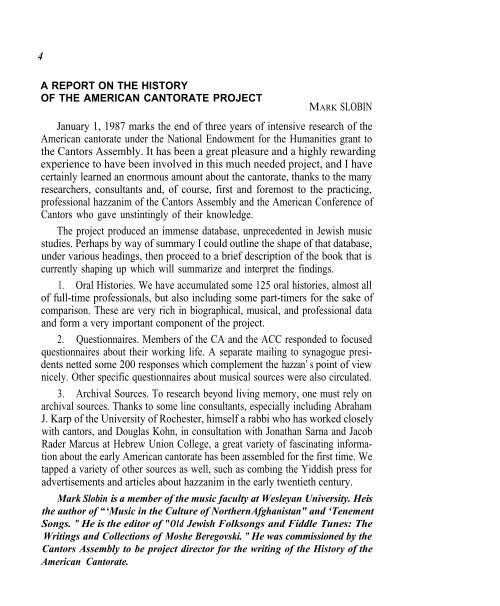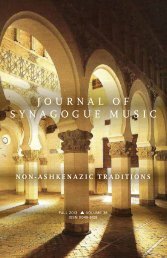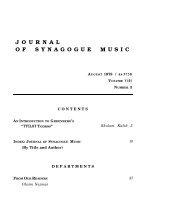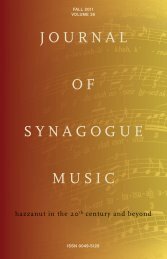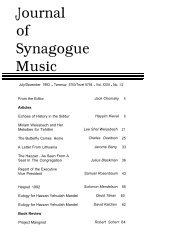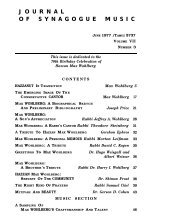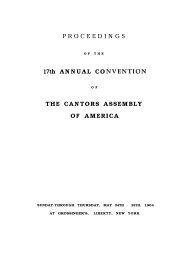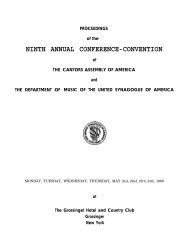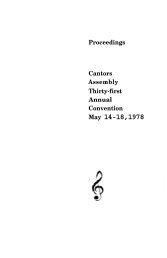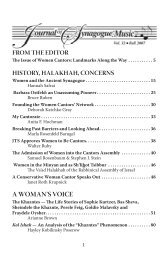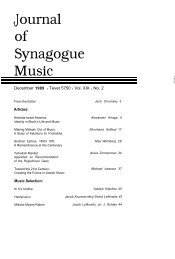Volume 16, Number 2 - Cantors Assembly
Volume 16, Number 2 - Cantors Assembly
Volume 16, Number 2 - Cantors Assembly
You also want an ePaper? Increase the reach of your titles
YUMPU automatically turns print PDFs into web optimized ePapers that Google loves.
4<br />
A REPORT ON THE HISTORY<br />
OF THE AMERICAN CANTORATE PROJECT<br />
MARK SLOBIN<br />
January 1, 1987 marks the end of three years of intensive research of the<br />
American cantorate under the National Endowment for the Humanities grant to<br />
the <strong>Cantors</strong> <strong>Assembly</strong>. It has been a great pleasure and a highly rewarding<br />
experience to have been involved in this much needed project, and I have<br />
certainly learned an enormous amount about the cantorate, thanks to the many<br />
researchers, consultants and, of course, first and foremost to the practicing,<br />
professional hazzanim of the <strong>Cantors</strong> <strong>Assembly</strong> and the American Conference of<br />
<strong>Cantors</strong> who gave unstintingly of their knowledge.<br />
The project produced an immense database, unprecedented in Jewish music<br />
studies. Perhaps by way of summary I could outline the shape of that database,<br />
under various headings, then proceed to a brief description of the book that is<br />
currently shaping up which will summarize and interpret the findings.<br />
1. Oral Histories. We have accumulated some 125 oral histories, almost all<br />
of full-time professionals, but also including some part-timers for the sake of<br />
comparison. These are very rich in biographical, musical, and professional data<br />
and form a very important component of the project.<br />
2. Questionnaires. Members of the CA and the ACC responded to focused<br />
questionnaires about their working life. A separate mailing to synagogue presidents<br />
netted some 200 responses which complement the hazzan’s point of view<br />
nicely. Other specific questionnaires about musical sources were also circulated.<br />
3. Archival Sources. To research beyond living memory, one must rely on<br />
archival sources. Thanks to some line consultants, especially including Abraham<br />
J. Karp of the University of Rochester, himself a rabbi who has worked closely<br />
with cantors, and Douglas Kohn, in consultation with Jonathan Sarna and Jacob<br />
Rader Marcus at Hebrew Union College, a great variety of fascinating information<br />
about the early American cantorate has been assembled for the first time. We<br />
tapped a variety of other sources as well, such as combing the Yiddish press for<br />
advertisements and articles about hazzanim in the early twentieth century.<br />
Mark Slobin is a member of the music faculty at Wesleyan University. He is<br />
the author of “‘Music in the Culture of Northern Afghanistan" and ‘Tenement<br />
Songs. ” He is the editor of "Old Jewish Folksongs and Fiddle Tunes: The<br />
Writings and Collections of Moshe Beregovski. ” He was commissioned by the<br />
<strong>Cantors</strong> <strong>Assembly</strong> to be project director for the writing of the History of the<br />
American Cantorate.


